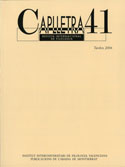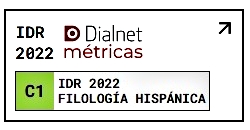Sobre alguns contrastos fonològics en l'entonació del català
DOI:
https://doi.org/10.7203/caplletra.41.4828Keywords:
Intonation, Categorial Perception, Tonal Contrast, Tonal Alienation Contrast, Tonal Height Contrast Abstract
Abstract
The main goal of this article is to provide evidence in favor of the phonological character of some intonational contrasts in Catalan. First, the article shows that tonal alignment differences with respect to metrically strong positions are crucial for the distinction between a yes-no question and a wh-question (cf. "¿Que l’ha llogada?" vs. "¿Qui l’ha llogada?") and between a command and a request ("¡Vine!" vs. "¡Vine!") in Central Catalan. Second, the article reports the major results from the application of the Categorical Perception Paradigm to a pitch height contrast in Majorcan Catalan
(Vanrell 2006a). Experimental resuls show that a small variation in the pitch height of the pretonic syllable is an important perceptual cue in distinguishing yes-no questions from wh-questions in this dialect ("¿Que l’hi duries?" vs. "¿Què li duries?"). The Catalan data demonstrate that small phonetic changes in pitch alignment and pitch scaling can be
crucial in the perception of intonation contours. Crucially, the data call for a revision of the autosegmental-metrical (AM) model of intonation: while the AM model predicts that differences in tonal alignment have the potential of creating phonological contrasts, it does not allow for phonological differences in pitch range.
 Downloads
Downloads
Downloads
Published
How to Cite
-
Abstract485
-
PDF (Català)108
Issue
Section
License
Authors submitting work to Caplletra for publication must be the legitimate holder of the usage rights. Legitimacy for the purposes of publishing the work must also include images, tables, diagrams and any other materials that may complement the text, whether they are the author of such material or not.
Copyright: on publishing their work in the journal, the author grants Caplletra. Revista Internacional de Filologia usage rights (reproduction, distribution and public communication) for both the paper printed version and for the electronic version.
All work published in Caplletra is covered by the Creative Commons license type Attribution-NonCommercial-NoDerivatives 4.0 (CC BY-NC-ND 4.0).
RESPONSABILITY
Caplletra. Revista Internacional de Filologia does not necessarily identify with the points of view expressed in the papers it publishes.
Caplletra. Revista Internacional de Filologia accepts no responsibility whatsoever for any eventual infringement of intellectual property rights on the part of authors.






